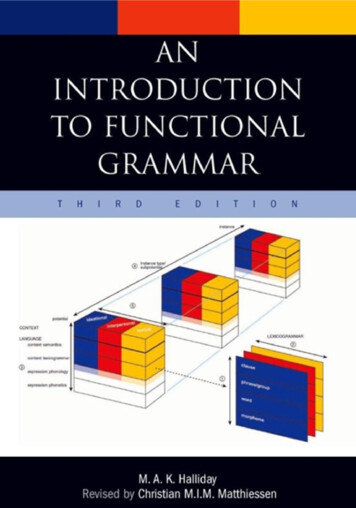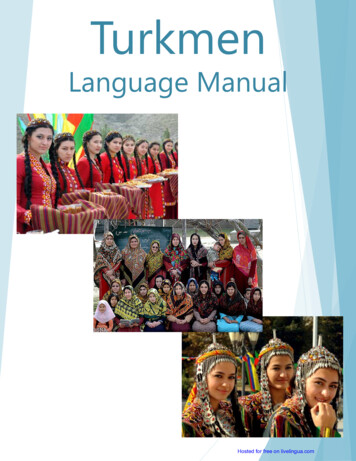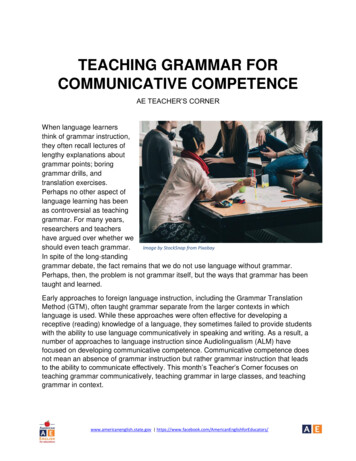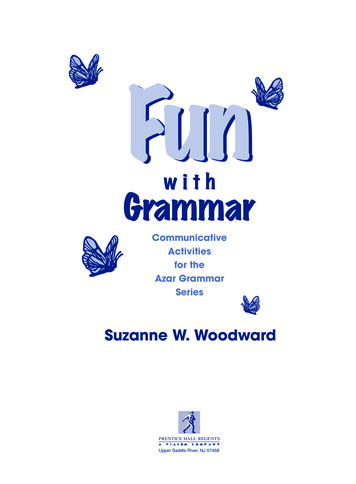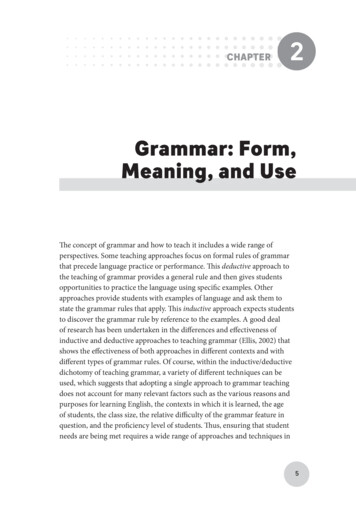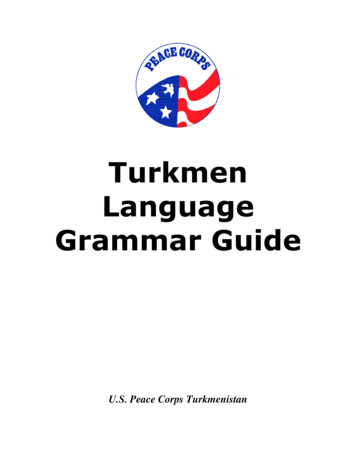
Transcription
TurkmenLanguageGrammar GuideU.S. Peace Corps Turkmenistan
Table of ContentsIntroduction .6Turkmen Language History .6The Five Branches of Turkic Languages .7Language Variation and Dialects . 7The Turkmen Alphabet .8Evolution of the Alphabet .8The Alphabet . 8Vowels .9Consonants . 9Short and Long Vowels . 10Vowel Harmony . 11Voiced and Unvoiced Consonants . 12Sound Assimilation/Letter Transformation. 12Vocal Transformations . 13The Case System . 14Cases and Their Suffixes . 14The Nominative Case . 15The Genitive Case . 15The Dative Case . 15The Accusative Case . 16The Locative Case . 16The Instrumental Case . 16Cases of Pronouns . 17Possessive Suffixes . 18Possessive Suffixes without a Genitive Case Subject . 18The Absolute Possessive: -ky/-ki . 18Referring to groups of people or things . 19Forming Questions: -my?/-mi? . 20Forming Plurals: -lar/-ler. 21Verb Overview . 22Present Tense . 23Simple Present, Emphatic Statement: -dyr/-dir . 24Past Tense . 25Action in the Distant Past: -yp/-ip . 25Expressing Unwitnessed Actions: -ypdyr/-ipdir . 26Expressing surprise: ―Eken‖ . 27Past Conditions . 27Future Tense . 28Definite Future . 28Indefinite Future . 28Expressing Intended Action in the Past . 29Anticipated Action: -jak/-jek bolmak . 31Future Conditions . 32Relative Clauses . 33
4 TURKMEN LANGUAGE GRAMMAR GUIDEPresent Tense . 33Past Tense . 34Future Tense . 34Relative Clauses in the Accusative Case . 35Relative Clauses without Nouns . 36Relative Clauses with ―-ky/-ki‖ . 36Relative Clauses with ―-ly/-li‖ . 37Expressing Intention. 38Imperative Forms/Commands . 39Requests . 39Informal Commands . 39Formal or Plural Commands . 39Less Formal, Polite Commands . 39Formal, Polite Request . 40Formal, Polite Commands . 40Encouraging Commands . 40Asking For Permission. 40Making Suggestions . 41Expressing Third-Person Desires . 42Obligatory Forms . 43Positive Obligatory Actions in the Past . 44Negative Obligatory Actions in the Past . 44Conditionals: . 46Simple Conditionals . 46Conditionals in the Present Tense . 47Conditionals in the Past Tense . 48Conditionals in the Future . 48Double Verbs . 50Expressing Ability: -yp/-ip/-p bilmek . 50Doing an Action for Someone: -yp/-ip/-p bermek . 51Beginning an Action: -yp/-ip/-p başlamak . 51Completing an Action: -yp/-ip/-p bolmak/gutarmak . 51Attempted Action: -yp/-ip/-p görmek . 52Expressing Continuous Action: Otyr, Ýatyr, Dur, Ýör, Barmak . 53Expressing Possibility . 55Requesting Permission: mümkinmi? . 56Indicating Likely Situations . 57Making a guess . 58Expressing Wants and Desires . 59Comparatives and Superlatives . 61Statements Expressing Time . 63Habitual Action In the Past . 63Statements With ―wagt‖ . 63Temporal Statements With ―-ka/-kä‖ . 64Constructing Time Clauses . 65Statements With ―Before‖ and ―After‖ . 65Expressing lengths of time . 66Statements With ―-ça/-çä‖. 67
Gerunds and Infinitives . 68Applying Dative Case to Verbs: -maga/-mäge . 68Gerunds with ―-yyş/-ýiş/-yş/-iş/-uş/-üş‖ . 69Imposing Desires on Others: -magyny/-megini . 69Postpositions . 71Other Important Grammatical Points . 72Bar and Ýok . 72The Verb ―Bolmak‖ . 72―In Order To‖ . 74Wondering . 75Causing . 75Reported Speech . 76Expressing Hearsay and Rumor: -myş/-miş . 77To Get The Attention ―Bara‖ . 78Verb Suffixes . 79Passive: -yl/-il, -ul/-ül, -l . 79Reflexive: -yn/-in, -un/-ün, -n . 79Reciprocal: -yş/-iş,-uş/-üş,-ş . 80Causative: -dyr/-dir, -dur/-dür, -yr/-ir, -ur/-ür, -uz/-üz, -ar/-er, -dar/-der, -t. 80Important Suffixes and Prefixes . 82-la/-le . 82-çy/-çi,-ýjy/-ýji,-yjy/-iji,-üji/-ujy . 82-dar . 82-keş. 82-syz/-siz/-suz/-süz . 83-ly/-li . 83bi- . 83-lyk/-lik/-luk/-lük . 83Diminutives. 84The ―-da/-de‖ ending as ―also‖ . 84―-da/-de‖ Ownuk Bölegi ―Hem‖ Manysynda . 84Some Common Mistakes Made by English Speakers . 85The Double Negative . 85―Eger,‖ ―Haçan,‖ and Conditionals. 85Definite vs. Indefinite Future . 86―Nähili?‖ vs. ―Nädip?‖ . 86Case Mix-ups . 87
6 TURKMEN LANGUAGE GRAMMAR GUIDEIntroductionThe Turkmen Language belongs to the greater family of Turkic languages. The Turkiclanguages, together with the Mongolian and Manchu-Tungus languages, form the Ural-Altaiclanguage group. Specifically, Turkmen is included in the sub-group of Southern Turkic (Oguz)languages, along with Turkish, Crimean Tatar, and Azeri. Southern Turkic is a sub-group ofCommon Turkic, which also includes Kazakh, Uzbek, Uigur, Kyrgyz, and others.Among all the Turkic languages, there are similar grammatical structures, similar phonetics,some shared vocabulary, and high mutual intelligibility. Some experts also consider Japaneseand Korean part of this phylum, or family, although evidence of this is debated.Turkmen is agglutinative, meaning its grammatical functions are indicated by adding varioussuffixes to fixed stems. Suffixes on nouns indicate number. In general, Turkmen employs aSubject-Object-Verb word order, as is typical for Turkic languages, but other orders are possiblein certain discourse situations. As such, Turkmen makes use of postpositions rather thanprepositions, and unique relative clauses that precede the verb. In some ways Turkmen is an easylanguage to learn. Unlike Russian or Spanish, Turkmen has no genders. There are no irregularverbs. For the most parts, words are written exactly as they are pronounced. Finally, Turkmen'sgrammatical case system is remarkably simple once understood, and has almost no exceptions.The greatest difficulty for beginning Turkmen speakers will probably be adapting to Turkmen‘selaborate system of grammatical suffixes, or ―tag words‖ and learning to re-order their speech sothat the predicate (verb) is the last thing spoken. Also, many simple English grammaticalstructures (such as ―to have,‖ ―to need,‖ ―to want,‖ and ―to be able to‖) are handled differently inTurkmen.Turkmen Language HistoryThe entrance of Turkic-speaking groups into the southwestern region of Central Asia by the fifthand sixth centuries gradually changed the area from Persian-speaking to Turkic-speaking. Thedecisive influx came when Oguz tribes migrated into the area between the Ural Mountains andthe Aral Sea around the 8th and 9th centuries. During this same period the term Turkmen wasfirst used to refer to these people. By the fourteenth and fifteenth centuries the Oguz tribes inTurkmenistan had coalesced to the point that they could be regarded as a single people. Althoughthey shared common traditions and the same language, they had strong divisions among them.Subnational and clan consciousness still predominates in Turkmenistan where Turkmen peopletend to divide themselves by origin and clan. The newly independent Turkmenistan state gainedindependence from the Soviet Union on October 27, 1991.The oldest monuments of Turkic languages—inscribed on stones and datable to the early 8thcentury CE—were discovered in the late 19th century in southern Siberia around the YeniseyRiver and in northern Mongolia near the capital of Urga (modern Ulaan-Baatar). Deciphered in1893 by the Danish scholar Vilhelm Thomsen, they provide valuable insights into the history ofCentral Asia around the seventh century CE. These records of the Turk dynasty (Chinese T'uchüeh) include texts found at Kosho-Tsaidam on the Orhon River, as well as several Chinese
texts. These texts throw light on the nomadic culture of the tribal empire controlled by the Turkdynasty (Gokturks), including shamanism, the calendar, customs, and social structure, withstrong Chinese influence detectable in the latter.The Five Branches of Turkic Languages1. Oguz, also known as Southern or Southwestern Turkic (includes the Turkish language, orOsmanli, the most widely used Turkic language, spoken in Turkey and the Balkan Peninsula;Azeri, spoken in Azerbaijan and northwestern Iran; and Turkmen, spoken in Turkmenistanand other parts of Central Asia;2. Kipchak, or Western Turkic (includes the Kazakh and Kyrgyz languages, spoken in CentralAsia; Tatar, spoken around the middle Volga, and in Turkey, the Balkans, Central Asia, andChina; Bashkort or Bashkir language, which is very similar to Tatar);3. Karluk or Eastern Turkic (includes Uzbek, spoken in Uzbekistan and other parts of CentralAsia and Uigur, spoken in the Xinjiang Uigur Autonomous Region of China, and parts ofCentral Asia);4. Northern Turkic, also known as Eastern Hunnic (consists of a number of languages spoken inSiberia, such as Yakut and Altay);5. And the single-language branch consisting of the Chuvash language, spoken along themiddle Volga River.Language Variation and DialectsTurkmen has numerous dialects, which differ phonologically and morphologically. They can bebroken into two general groups: the major or central dialects and others on the periphery. Thefollowing dialects, generally regarded as major, also denote tribal distinctions: Yomut, Teke,Salir, Sarik, Goklen, Arsari, and Chowdur. No consensus exists, however, on exactly how manymajor dialects should be recognized within Turkmen.Some scholars claim that the standard language is based on just one dialect—Yomut. Mostlinguists, however, acknowledge that Yomut and Teke are the two dialects whose contributionsto the formation of the standard language since 1920 surpass those of any other dialect.
8 TURKMEN LANGUAGE GRAMMAR GUIDEThe Turkmen AlphabetTürkmen ElipbiýiEvolution of the AlphabetElipbiýiň taryhyThe Turkmen alphabet was first written in the Arabic script, until about 1929, when the ―UnifiedTurkish Latin Alphabet‖ (UTLA), which was based on the Roman alphabet, was introduced.This alphabet was very similar to the Roman alphabet currently used for the Turkish language.The UTLA script was replaced in 1940 when all Turkic people in the Soviet Union were requiredto adopt the Cyrillic script. Finally, in 1995, the ―Täze Türkmen Elipbiýi,‖ or New Alphabet,was formally introduced by President Niyazov to re-align Turkmenistan with the non-Sovietworld. Similar new alphabets have been introduced in Uzbekistan and other republics.The New Alphabet is currently used for street signs and political slogans, but there is a shortageof other reading materials. Most Turkmen books in print are older and use the Cyrillic alphabet.The new alphabet is used for new Turkmen texts, instruction in schools, and for all officialdocuments. Despite this, there has been no push for the older generation to learn the newalphabet and therefore newspapers, information, and other resources are often available in bothalphabets.The new alphabet (Täze Elipbiý), containing nine vowels and twenty-one consonants, is mucheasier for native English speakers to read and understand than the Cyrillic, and also seems bettersuited to the Turkmen language. For this reason we have used it in the grammar discussions ofthis text. Most letters are pronounced more or less like their English counterparts.The AlphabetTäze ElipbiýThe following is a list of the letters of the new Turkmen alphabet and English approximations ofhow to pronounce their Turkmen ��theh‖*For these letters it is impossible to approximate a phonetical spelling using English letters. ―Ä‖is pronounced like the ―a‖ in ―apple.‖ The first ―h‖ in ―heh‖ should be pronounced as a fricativein the throat like the ―ch‖ in ―Bach.‖ ―R‖ is not pronounced like the ―er‖ in the English word―writer.‖ There should be a slight roll of the tongue on the ―r,‖ as in Spanish or Russian. ―Ö,‖―ü,‖ and ―y‖ are vowels that do not appear in English. For their pronunciations, see below. Itshould be noted that different dialects have different pronunciations for some consonants. Forexample, s‘s and z‘s are not always lisped.
Like in all languages the Turkmen alphabet can be divided into two groups: vowels (çekimlisesler) and consonants (çekimsiz sesler).vowels (çekimli sesler)consonants (çekimsiz sesler)a, e, ä, i, o, ö, u, ü, yb, ç, d, f, g, h, j, ž, k, l, m, n, ň, p, r, s, ş, t, w, ý, zVowelsÇekimlilerShort vowels are approximately like simple vowels in standard American English. English hasno true equivalents of long vowels because it has ―diphthongs‖ or double vowels that aredifferent from each other. For example, in pronouncing the word ―wrote,‖ English speakersactually make o into two different vowels (oh--ooh). The sound of long vowels can beapproximated by extending the pronunciation of a short vowel for the duration of two vowels.The nine vowels of Turkmen are represented by the following letters or letter-groups:
The greatest difficulty for beginning Turkmen speakers will probably be adapting to Turkmen's elaborate system of grammatical suffixes, or ―tag words‖ and learning to re-order their speech so that the predicate (verb) is the last thing spoken. Also, many simple English grammatical

